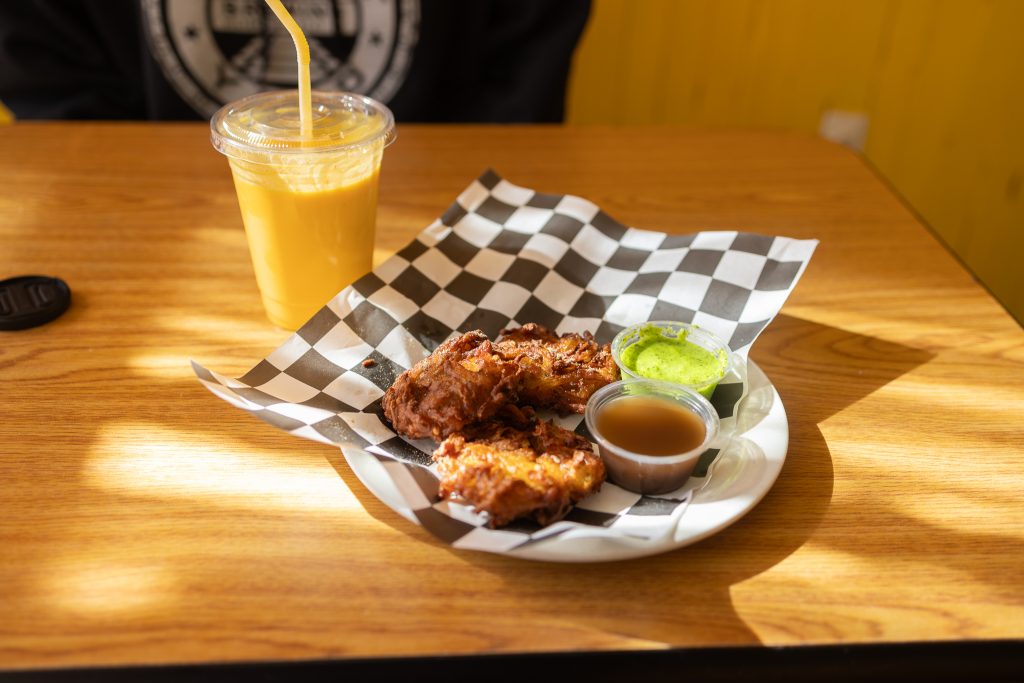Just over one year ago, Manish Verma was operating his restaurant, Spice of India, as a pop-up shop out of the Cornell Cooperative Extension on Upper Front Street. Now, due to an exuberant community response, Verma, 37, of Vestal, years ahead of schedule, operates his restaurant at a storefront on Vestal Avenue.
On a picturesque fall day, my photographer, Caspar, and I made our way to the heart of Binghamton’s South Side to sample Spice of India’s Restaurant Week lunch menu. With the familiar long winter approaching, we knew a hearty meal would be the perfect way to end the week.
For our appetizer, I opted for the mango lassi, a fresh beverage with a creamy yogurt base. Notably, it wasn’t too sweet, and it contrasted perfectly with the warm sunshine. Caspar chose the onion pakora, an Indian street food consisting of battered and fried onions and chickpeas, served with a refreshing mint chutney and a sweet tamarind one.
The pakora, in particular, was the undisputed star of the meal. Light, crispy and perfectly golden brown, we found it wasn’t too oily or heavy, and we weren’t alone. Looking around the dining room, it was clear the pakora had found a home on almost every table.
Looking toward our main course, Spice of India offered street bowls customizable for toppings and spice levels. I chose medium spiciness and potato curry and dal tadka — a north Indian lentil dish — to accompany a bed of fluffy basmati rice. The food came out piping hot, the potatoes were soft and the dal was smooth.
For his entree, Caspar chose medium spiciness, chickpea curry and butter chicken. The chicken thighs were juicy and flavorful and the chickpeas were tender.
The restaurant was colorful and inviting, a true hidden gem about one mile from Downtown Binghamton. As a lover of Indian cuisine, I was shocked I had not heard of Spice of India before. Clearly, others got the message — the dining room was full and a variety of community members stopped in while we were dining.
For dessert, I chose the kheer, a rice pudding with cardamom I jumped at as soon as I saw it on the menu. Caspar chose the gulab jamun, deep-fried dough balls in a warm, rose-flavored sugar syrup. The pudding was creamy, refreshing and just slightly sweet, the perfect end to a heavy meal. The gulab jamun was soft, perfectly fried and steaming hot.
After a delicious meal, Verma emerged from the kitchen and, after giving him our compliments, we had the opportunity to ask him about his background and culinary training. Hailing from New Delhi, India’s capital located in the country’s north, Verma said his grandfather operated a tomato ketchup factory, so running an eatery was “in the genes.”
“I got the opportunity to work for some kitchens, some Indian restaurants too, and that’s where I picked up this art of cooking,” Verma told me. “I’m from North India [and] my mother cooks for us when we are back home, so wherever I needed inspiration — how to make a certain dish in a certain way — my mom was just a phone call away, and she helped me get better at it.”
Verma described the community response as “absolutely amazing” and that he sold out every night for the first week of Spice of India’s opening. He said he planned on participating in Restaurant Week again.
Independently owned restaurants with strong roots stand out, and the love, dedication and intention shine through in not just the food, but the people making it. For not just its delicious menu and cozy location, we highly recommend Spice of India because of its emphasis on community.



